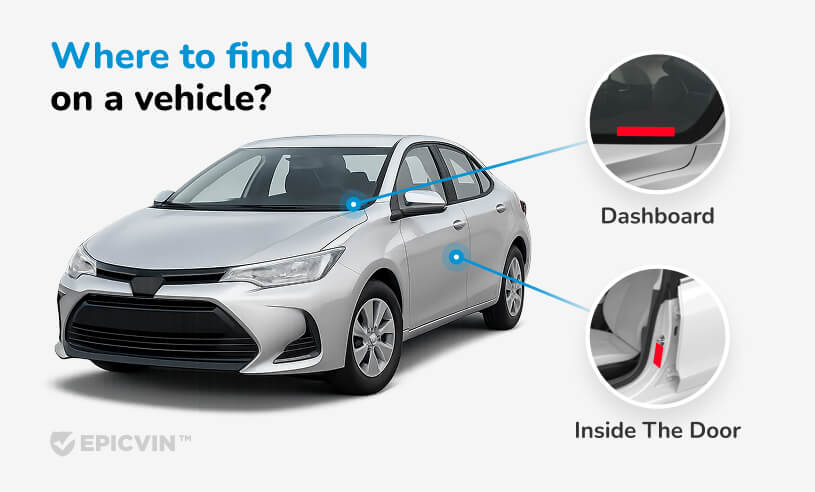
How to Read a VIN Number Like a Pro
From understanding the VIN number breakdown to uncovering a vehicle’s history,...

Free Volvo VIN Decoder! 🚗 See specs, build sheet, recalls basic history—no sign-up. 🛡️✅ Need accidents, mileage, title? Upgrade in one click.
Looking for the VIN?
Here is there you’ll find it:

Since 1981, every Volvo car and truck manufactured has followed the ISO Institute standard 17-character VIN system. A VIN decoder helps identify your vehicle's specs, recall status, and safety information instantly. Use this tool to check accident and title records in Volvo cars and trucks with just one click.
Our VIN decoder simplifies the process for any Volvo owner or buyer.

Your Volvo VIN appears in several standard locations for easy identification.
| Key Risk | Impact on Buyers | Mitigation Steps |
|---|---|---|
| Theft Risk | U.S. luxury SUVs like the XC90 are stolen at ~1.5x the national average | Use VIN to check local theft reports. |
| Unrepaired Safety Recalls | ~1,000 Volvos from June 2025 brake recall still unpatched. | Check recall status via VIN; update AWD/OTA. |
| Depreciation Over Time | Luxury Volvos hold ~50% value at 5 years - steeper than mainstream. | Compare via the EpicVIN value estimator. |
| Odometer Rollback Fraud | Fraud occurs in ~2% of used Volvo listings in salvage auctions. | Always verify mileage history via VIN. |
| Hidden Flood or Salvage History | ~0.5% of Volvos in auctions show hidden water damage. | Always view EpicVIN photos & NMVTIS history. |
Minimize risks: Check VIN history through EpicVIN or NMVTIS. Track records of mileage rollback and open recalls. Carefully review the car's history photos.
| Issue | Affected Models & Symptoms | Avg Repair Cost (USD) |
|---|---|---|
| Transmission failure (AW55 50/51) | XC90 & V70 (2007–2012), harsh shifts, slips under 50,000 mi | $2,500–$4,000 |
| Power-steering pump/hose leaks | XC60 (2010–2014), whining noise, steering effort loss | $1,200–$1,800 |
| Excessive oil consumption (S60) | S60 (2010–2012), frequent oil top-offs, visible smoke | $800–$1,500 (ring replacement) |

Each character in your vehicle's unique sequence tells a specific story through individual digits that function to identify key specifications.
There are some other details that Volvo owners and buyers should know:
Here's how our Volvo VIN decoder interprets a sample sequence where each position has a specific function (7JR102FK6KG001402):
| Symbols | Sample | What It Reveals |
|---|---|---|
| 1 | 7 | The United States as the country of origin |
| 2 | J | Volvo as a manufacturer |
| 3 | R | Truck/SUV vehicle type |
| 4-8 | 102FK | Body style, engine type, restraint system, model line, and trim level |
| 9 | 6 | Check digit for validation |
| 10 | K | 2019 model year |
| 11 | G | Assembly plant code |
| 12-17 | 001402 | Individual vehicle serial number |
Year 2009
Make Volvo
Model 9700
Fuel Type
Engine D13 Diesel
Made in MEXICO
Your Volvo VIN reveals comprehensive vehicle data through our decoder system, including truck specifications when applicable.
Every new U.S. Volvo VIN is indexed the same day - we deliver timely history for confident buying.Alex Black, CMO, EpicVIN
Check the dashboard corner through the windshield, driver's door jamb, engine compartment, or registration documents for the 17-character code with specific digits.
Yes, VIN position 5-6 codes indicate safety equipment packages, including City Safety standard, on most modern Volvo models.
The letter "E" in VIN position 7 typically designates plug-in hybrid or electric drivetrain configurations in Volvo vehicles.
Specific VIN ranges vary by model; check the NHTSA database with your exact VIN for June 2025 brake recall coverage.
VIN position 6-7 characters typically indicate drivetrain configuration, distinguishing between all-wheel drive and front-wheel drive systems.
Cross Country variants use specific model codes in VIN positions 4-8, varying by model year and platform generation.
VIN equipment codes in positions 5-8 may indicate LED headlight packages, though specific Thor's Hammer design requires model verification.
VIN position 6-7 typically contains transmission codes distinguishing manual, automatic, CVT, or hybrid transmission types in Volvo vehicles.
Yes, VIN safety equipment codes can indicate IntelliSafe packages that include adaptive cruise control and pilot assist features.
Canadian-market Volvos typically share VIN prefixes with U.S. models (YV1, YV4, 7JR) but have specific equipment codes.
Discover expert tips, news and advice on buying and maintaining used vehicles

From understanding the VIN number breakdown to uncovering a vehicle’s history,...

If you're in the market for a fast and affordable vehicle, read our detailed r...

In our article, you will learn how to read our vehicle history reports.